Knowledge mapping visualization analysis of the military health and medicine papers published in the web of science over the past 10 years
- PMID: 28717517
- PMCID: PMC5508635
- DOI: 10.1186/s40779-017-0131-8
Knowledge mapping visualization analysis of the military health and medicine papers published in the web of science over the past 10 years
Abstract
Background: Military medicine is a research field that seeks to solve the medical problems that occur in modern war conditions based on public medicine theory.
Methods: We explore the main research topics of military health and medical research in the web of science™ core collection (WoSCC) from 2007 to 2016, and the goal of this work is to serve as a reference for orientation and development in military health and medicine. Based on CiteSpace III, a reference co-citation analysis is performed for 7921 papers published in the WoSCC from 2007 to 2016. In addition, a cluster analysis of research topics is performed with a comprehensive analysis of high-yield authors, outstanding research institutions and their cooperative networks.
Results: Currently, the research topics in military health and medicine mainly focus on the following seven aspects: mental health diagnoses and interventions, an army study to assess risk and resilience in service members (STARRS), large-scale military action, brain science, veterans, soldier parents and children of wartime, and wound infection. We also observed that the annual publication rate increased with time. Wessely S, Greenberg N, Fear NT, Smith TC, Smith B, Jones N, Ryan MAK, Boyko EJ, Hull L, and Rona RJ were the top 10 authors in military health and medicine research. The top 10 institutes were the Uniformed Services University of the Health Sciences, the United States Army, the United States Navy, Kings College London, Walter Reed National Military Medical Center, Boston University, Walter Reed Army Institute of Research, Walter Reed Army Medical Center, Naval Health Research Center, and the VA Boston Healthcare System.
Conclusions: We are able to perform a comprehensive analysis of studies in military health and medicine research and summarize the current research climate and the developmental trends in the WoSCC. However, further studies and collaborations are needed worldwide. Overall, our findings provide valuable information and new perspectives and shape future research directions for further research in the area of military health and medicine.
Keywords: CiteSpace; Knowledge mapping; Military health; Military medicine.
Conflict of interest statement
Ethics approval and consent to participate
Not applicable.
Consent for publication
Not applicable.
Competing interests
The authors declare that they have no competing interests.
Figures
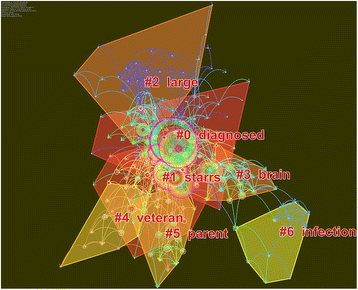
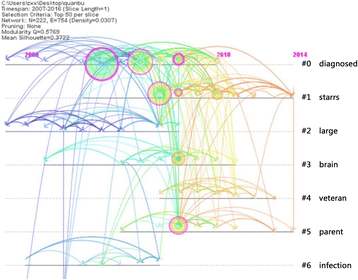
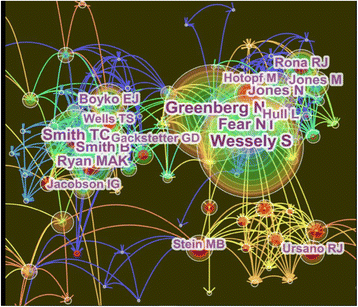
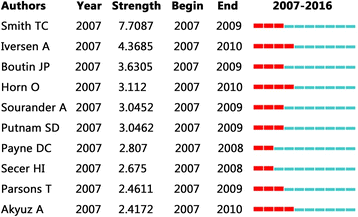
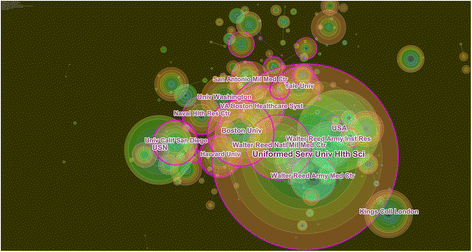
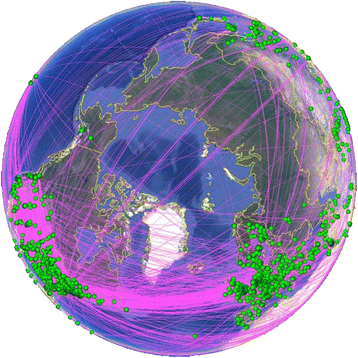
Similar articles
-
The founding of Walter Reed General Hospital and the beginning of modern institutional army medical care in the United States.J Hist Med Allied Sci. 2014 Oct;69(4):521-53. doi: 10.1093/jhmas/jrt016. Epub 2013 Jul 8. J Hist Med Allied Sci. 2014. PMID: 23839016
-
The Walter Reed Army Medical Center Nephrology Service website: a tool for military-wide provider and patient education.Mil Med. 2000 Mar;165(3):189-92. Mil Med. 2000. PMID: 10741080
-
Realizing Major William Borden's dream: military medicine, Walter Reed Army Medical Center, and its wounded warriors, 1909-2009: an essay review.J Hist Med Allied Sci. 2011 Jul;66(3):380-94. doi: 10.1093/jhmas/jrq042. Epub 2010 Jun 23. J Hist Med Allied Sci. 2011. PMID: 21724648
-
United States Army Research Institute of Environmental Medicine: Warfighter research focusing on the past 25 years.Adv Physiol Educ. 2011 Dec;35(4):353-60. doi: 10.1152/advan.00049.2011. Adv Physiol Educ. 2011. PMID: 22139770 Review.
-
Acute Pathophysiology of Blast Injury—From Biomechanics to Experiments and Computations: Implications on Head and Polytrauma.In: Kobeissy FH, editor. Brain Neurotrauma: Molecular, Neuropsychological, and Rehabilitation Aspects. Boca Raton (FL): CRC Press/Taylor & Francis; 2015. Chapter 18. In: Kobeissy FH, editor. Brain Neurotrauma: Molecular, Neuropsychological, and Rehabilitation Aspects. Boca Raton (FL): CRC Press/Taylor & Francis; 2015. Chapter 18. PMID: 26269922 Free Books & Documents. Review.
Cited by
-
Bibliometric visualization analysis of gut-kidney axis from 2003 to 2022.Front Physiol. 2023 Jun 9;14:1176894. doi: 10.3389/fphys.2023.1176894. eCollection 2023. Front Physiol. 2023. PMID: 37362429 Free PMC article. Review.
-
Bibliometric and Visual Analysis of Research on the Links Between the Gut Microbiota and Depression From 1999 to 2019.Front Psychiatry. 2021 Jan 8;11:587670. doi: 10.3389/fpsyt.2020.587670. eCollection 2020. Front Psychiatry. 2021. PMID: 33488420 Free PMC article.
-
Trends in conjunctivochalasis research from 1986 to 2017: A bibliometric analysis.Medicine (Baltimore). 2018 Sep;97(39):e12643. doi: 10.1097/MD.0000000000012643. Medicine (Baltimore). 2018. PMID: 30278590 Free PMC article. Review.
-
Immune cells regulate matrix metalloproteinases to reshape the tumor microenvironment to affect the invasion, migration, and metastasis of pancreatic cancer.Am J Transl Res. 2022 Dec 15;14(12):8437-8456. eCollection 2022. Am J Transl Res. 2022. PMID: 36628243 Free PMC article.
-
Bibliometrics Analysis of the Research Status and Trends of the Association Between Depression and Insulin From 2010 to 2020.Front Psychiatry. 2021 Jul 22;12:683474. doi: 10.3389/fpsyt.2021.683474. eCollection 2021. Front Psychiatry. 2021. PMID: 34366917 Free PMC article. Review.
References
-
- Linde AS, Kunkler K. The Evolution of medical training simulation in the U.S. military. Stud Health Technol Inform. 2016;220:209–214. - PubMed
Publication types
MeSH terms
LinkOut - more resources
Full Text Sources
Other Literature Sources
Research Materials
Miscellaneous

